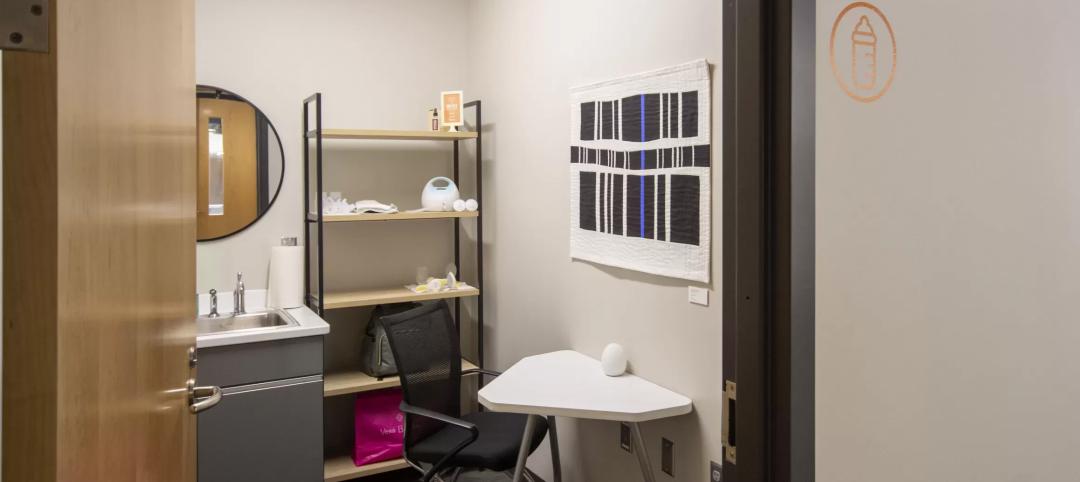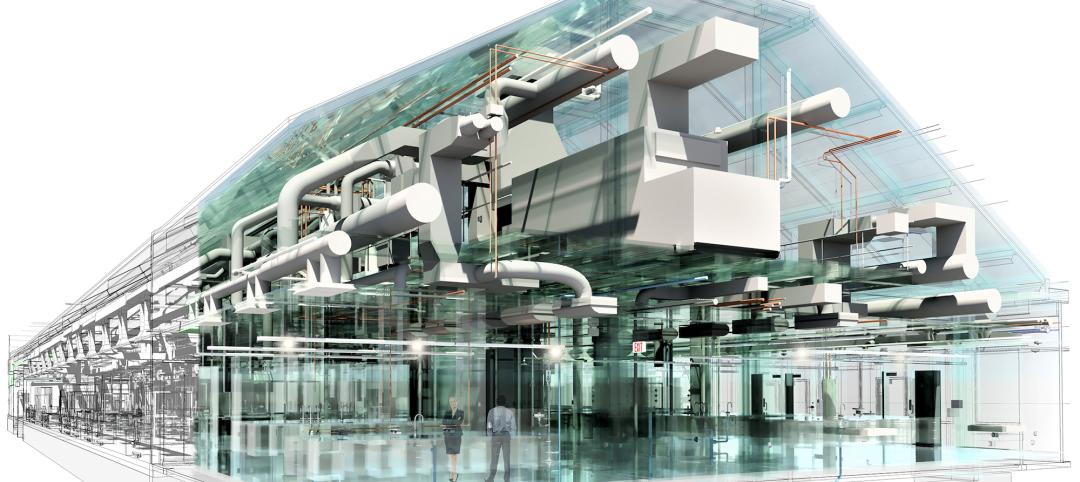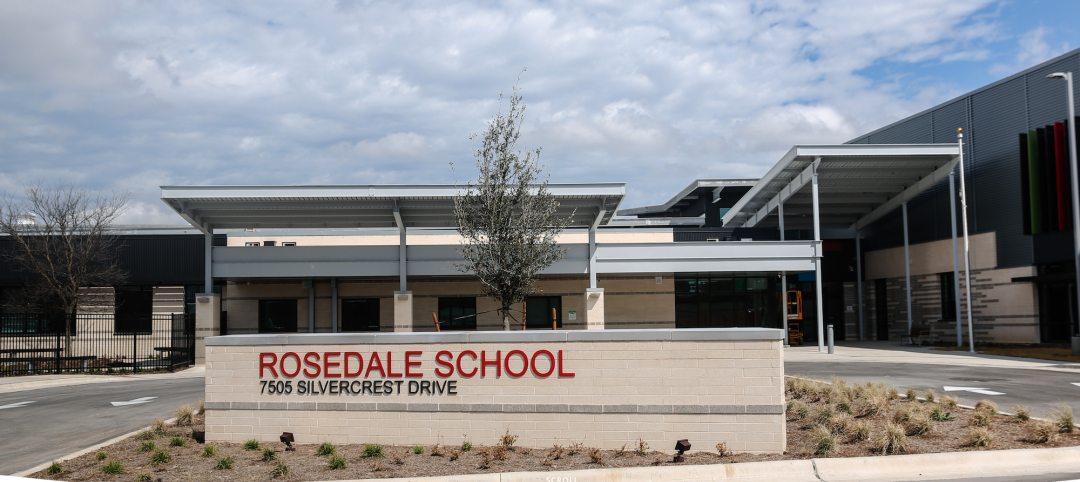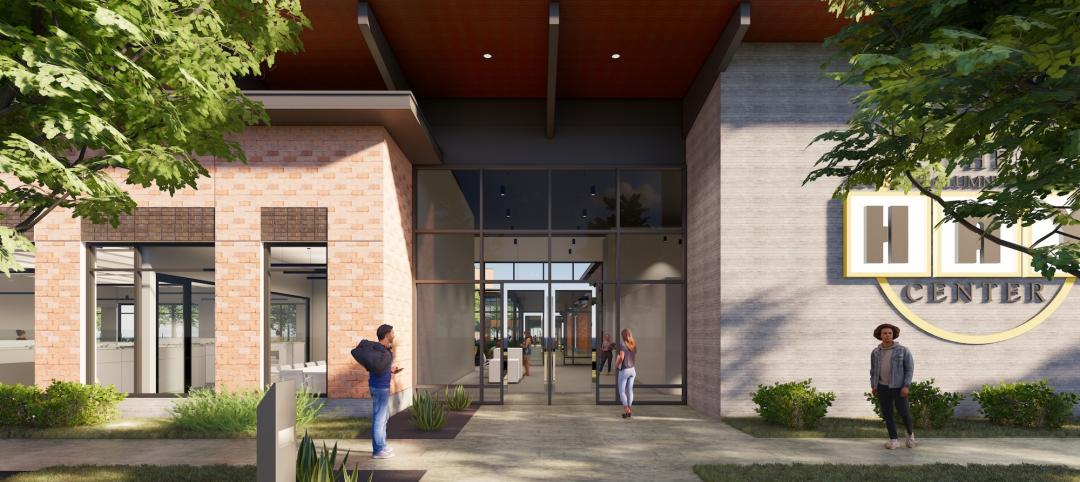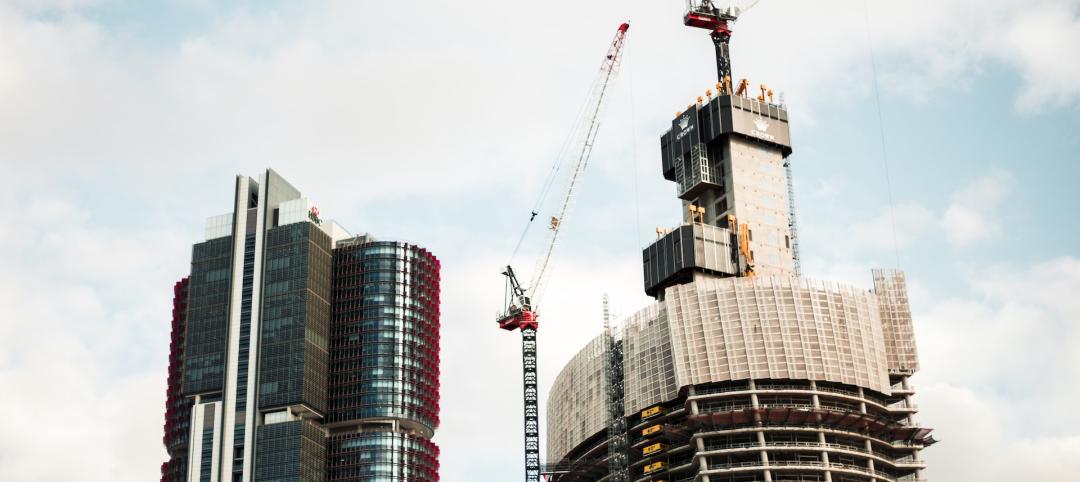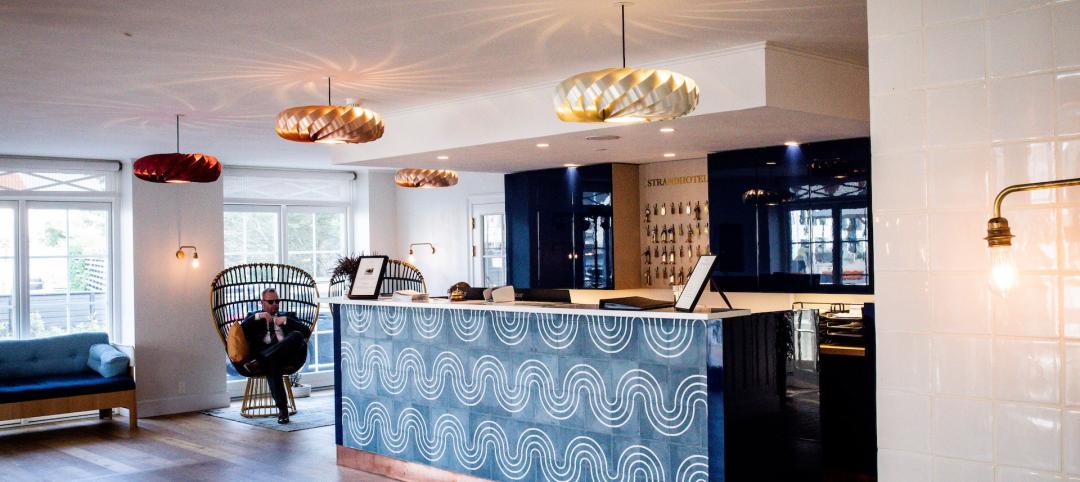2012 Building Team Awards
Platinum Award
Six years ago, and worlds away in terms of economic conditions, Rush University Medical Center unveiled ambitious plans for a 10-year campus redevelopment project on the Near West Side of Chicago. At a cost of $654 million, the cornerstone of the transformation was an 840,000-sf, 14-story butterfly-shaped hospital building, called the Tower, that included a technologically advanced emergency room prepared to handle any type of pandemic or chemical, biological, or radiological disaster that might strike Chicago.
In July 2008, steel erection was nearly 30% complete when the global financial crisis hit. Rush officials were concerned they might not be able to obtain the necessary funding to complete the project.
The Building Team, led by the Power/Jacobs Joint Venture—an affiliation of Power Construction Co., Schaumburg, Ill., and Jacobs Engineering Group, Pasadena, Calif. (PM/CM), and architect Perkins+Will, Chicago—worked to develop a financial plan that would allow the project to keep moving. A multi-prime contracting strategy enabled the Building Team to award contracts to multiple prime contractors based on when the work was ready to be bid and start. More to the point, the plan was flexible enough to slow down or stop construction at any time without committing to the balance of the contracts.
As construction proceeded during the economic meltdown, the Building Team was able to help Rush remain on course financially while pushing the limits of value-added engineering and construction.
In late 2011, Rush and the Building Team unveiled a LEED-NC Gold tower that was completed on time and within budget, thanks, in part, to the multi-prime contracting strategy.
In singling out Rush University Medical Center by awarding a Platinum designation, the judges for Building Design+Construction’s 2012 Building Team Awards recognized the Rush Building Team for overcoming the unforeseen financial constraints, developing a structural redesign of the tower that saved Rush $40 million, and completing one of the most innovative emergency response centers in the U.S.
“For a job of that size to get done during the recession is pretty impressive,” says Building Team Award Judge Jeremy Oremland, a financial analyst with Magellan Development Group LLC, Chicago.
COLLABORATION ON DESIGN CONCEPT, STRUCTURAL COMPLICATIONS
Perkins+Will worked closely with hospital clinicians during the design phase to create a new hospital building that would embrace patient comfort, safety, efficiency, and quality of care—ultimately, a facility that would house 304 acute care and critical care beds, 72 private neonatal intensive care rooms, 28 operating rooms, 14 procedure rooms, and 10 labor, delivery, and recovery rooms.
“Rush’s Office of Transformation organized task forces chaired by selected leaders from the client side, who met over the course of several months with the Building Team to discuss specific aspects and departments of the project,” says Bridget Lesniak, AIA, a principal with Perkins+Will.
Task forces for each department met with the Building Team to plan layouts that accentuated the hospital’s best operational practices while discouraging inefficient ones.
For example, the Hospital Building Standards task force reviewed architectural and MEP systems for all typical rooms, which provided vital information regarding operations, product selection, liability, infection control, and clinical concerns. “Especially standardization, which was the main driver for this project,” says Lesniak.
The innovations developed between the Office of Transformation and the Building Team included:
- The butterfly shape, which gives nurses a clear sightline to patient rooms and puts them closer to patients.
- Operating-room quality air throughout all patient care areas, and even higher quality air circulation in surgical suites.
- Single-bed rooms designed with separate zones for the patient, the patient’s family, and staff. Patient rooms have a uniform design, so physicians and nurses will find the same equipment in the same place to ensure seconds are not lost in an emergency.
GETTING THE TOWER TO SIT RIGHT
Meanwhile, the structural design for the 14-story Tower faced complications. Initial designs had its base connected directly to the basement of Rush’s existing hospital building, which extended 30 feet under the new facility.
“The lower level of the existing building extended a significant distance below grade in the direction of the new addition,” says Lesniak. “Attempting to put in foundations for a 14-story building in this location would have been very expensive and extremely time consuming.”
The Building Team assembled for a constructability and value engineering session. The solution: pull the two buildings apart and redesign the new hospital building.
Project summary
PLATINUM AWARD
Rush University Medical Center Transformation Program – Tower (Phase II), Chicago, Ill.Building Team
Submitting firm: Power/Jacobs Joint Venture
Owner/developer: Rush University Medical Center
Architect: Perkins+Will
Structural engineer: Thornton Tomasetti
MEP engineer: Environmental Systems Design
General contractor/Construction manager: Power/Jacobs Joint Venture, Rush UniversityGeneral Information
Size: 840,000 sf
Construction cost: $654 million
Construction period: July 2008 to July 2011
Delivery method: PM/CM agency multi-prime
Separating the new and existing hospital structures actually simplified the foundations, eliminated supercolumns, and allowed a rectilinear column grid that eliminated the need for a transfer truss system. A multistory bridge was built to connect the Tower back to the existing building, a structural redesign that saved more than $40 million and resulted in a more finely engineered building with no reduction in scope.
The newly created space between the two buildings allowed for the inclusion of the three-story, 10,000-sf Edward A. Brennan Entry Pavilion, made possible through $16 million in private donations. It features a four-story terrarium that is open to the elements, circular skylights that provide natural lighting, seating areas, and a centrally located reception area.
Even though it was a late addition to the Rush transformation program—the Tower’s steel and concrete structure was complete and 50% enclosed—the Brennan Entry Pavilion was finished three months ahead of schedule and in time for the grand opening.
Other cost-saving efforts by the Building Team included:
- The application of simulation modeling to review and validate the operational space program, which led to improvements in the utilization of numerous spaces—saving $7.8 million.
- A strategy for mitigating floor moisture to avoid the application of accelerants—saving $5 million.
- Reengineering the support steel for patient lifts and booms and lights—saving $1.05 million.
- Negotiating consultant and contractor proposals—saving $26 million.
MILITARY APPROACH TO THE EMERGENCY DEPARTMENT
Unique to the Rush new facilities is the first-floor Emergency Department, which houses the Robert R. McCormick Foundation Center for Advanced Emergency Response.
“This is the nation’s first facility designed to provide care for patients involved in chemical, biological, and radiological disasters,” says Dr. Dino Rumoro, Rush’s chair of emergency medicine. “We have to be ready for any type of disaster that can hit the city of Chicago.”
Modeled after a military emergency command center, the room measures 40,000 sf and includes 60 beds in three pods of 20 rooms each. Each patient room is fitted with a double set of gas and electrical outlets. In the event of a mass casualty situation, two patients can be placed in each room.
In case extra capacity is needed, gas and electrical outlets are hidden behind panels on columns in the adjacent Edward A. Brennan Entry Pavilion.
“Many new emergency departments are building in disaster response features, but none to the capacity that we have done by incorporating large-scale decontamination, respiratory infectious illness, and surge capacity,” says Dr. Rumoro.
Traditional emergency rooms have decontamination areas and showers to serve up to six patients. Rush’s emergency response center can serve and decontaminate several hundred patients in one hour. The ambulance bay can also be closed to vehicles, and decontamination showers can be set up to wash down large numbers of patients simultaneously. Contaminated water is collected in a 10,000-gallon tank rather than directly discharged into the city sewer system.
“The hope is Rush developed a model for future emergency department design and Centers for Advanced Emergency Response will be required in the future for hospitals in large population centers,” says Dr. Rumoro.
At a ceremony for Rush’s new Tower in December 2011, Dr. Larry Goodman, CEO of Rush, said, “This was a dedicated team effort by our board, staff, and management to create a 10-year plan to address our needs while improving clinical care.”
Building Team Award Judge Peter Rumpf, integrated construction manager for Mortenson Construction, Elk Grove Village, Ill., echoed Goodman’s comments: “It was a very complex job that took a lot of collaboration and communication between the owner and the Building Team in order to successfully complete the project.” BD+C
--
Click here to view exclusive video interviews of the 2012 Building Team Awards judges explaining their selections.
Related Stories
Office Buildings | Aug 1, 2023
Creating a nurturing environment: The value of a mother’s room in the workplace
Since becoming an architect, Rebecca Martin of Design Collaborative has drawn a mother’s room into numerous projects. But it wasn't until she became a mom that she fully appreciated their importance in the workspace.
Digital Twin | Jul 31, 2023
Creating the foundation for a Digital Twin
Aligning the BIM model with the owner’s asset management system is the crucial first step in creating a Digital Twin. By following these guidelines, organizations can harness the power of Digital Twins to optimize facility management, maintenance planning, and decision-making throughout the building’s lifecycle.
K-12 Schools | Jul 31, 2023
Austin’s new Rosedale School serves students with special needs aged 3 to 22
In Austin, the Rosedale School has opened for students with special needs aged 3 to 22. The new facility features sensory rooms, fully accessible playgrounds and gardens, community meeting spaces, and an on-site clinic. The school serves 100 learners with special needs from across Austin Independent School District (ISD).
MFPRO+ New Projects | Jul 27, 2023
OMA, Beyer Blinder Belle design a pair of sculptural residential towers in Brooklyn
Eagle + West, composed of two sculptural residential towers with complementary shapes, have added 745 rental units to a post-industrial waterfront in Brooklyn, N.Y. Rising from a mixed-use podium on an expansive site, the towers include luxury penthouses on the top floors, numerous market rate rental units, and 30% of units designated for affordable housing.
Affordable Housing | Jul 27, 2023
Houston to soon have 50 new residential units for youth leaving foster care
Houston will soon have 50 new residential units for youth leaving the foster care system and entering adulthood. The Houston Alumni and Youth (HAY) Center has broken ground on its 59,000-sf campus, with completion expected by July 2024. The HAY Center is a nonprofit program of Harris County Resources for Children and Adults and for foster youth ages 14-25 transitioning to adulthood in the Houston community.
Hotel Facilities | Jul 27, 2023
U.S. hotel construction pipeline remains steady with 5,572 projects in the works
The hotel construction pipeline grew incrementally in Q2 2023 as developers and franchise companies push through short-term challenges while envisioning long-term prospects, according to Lodging Econometrics.
Sustainability | Jul 27, 2023
USGBC warns against building energy code preemptions, rollbacks
In a recent editorial, the USGBC cited a growing number of U.S. state legislators who are “aiming to roll back building energy code standards and/or preempt local governments from advancing energy-efficient building codes.”
Resiliency | Jul 27, 2023
'Underground climate change' can damage building foundations, civil infrastructure
A phenomenon known as “underground climate change” can lead to damage of building foundations and civil infrastructure, according to a researcher at Northwestern University. When the ground gets hotter, it can expand and contract, causing foundations to move and sometimes crack.
Adaptive Reuse | Jul 27, 2023
Number of U.S. adaptive reuse projects jumps to 122,000 from 77,000
The number of adaptive reuse projects in the pipeline grew to a record 122,000 in 2023 from 77,000 registered last year, according to RentCafe’s annual Adaptive Reuse Report. Of the 122,000 apartments currently undergoing conversion, 45,000 are the result of office repurposing, representing 37% of the total, followed by hotels (23% of future projects).
Hotel Facilities | Jul 26, 2023
Hospitality building construction costs for 2023
Data from Gordian breaks down the average cost per square foot for 15-story hotels, restaurants, fast food restaurants, and movie theaters across 10 U.S. cities: Boston, Chicago, Las Vegas, Los Angeles, Miami, New Orleans, New York, Phoenix, Seattle, and Washington, D.C.



